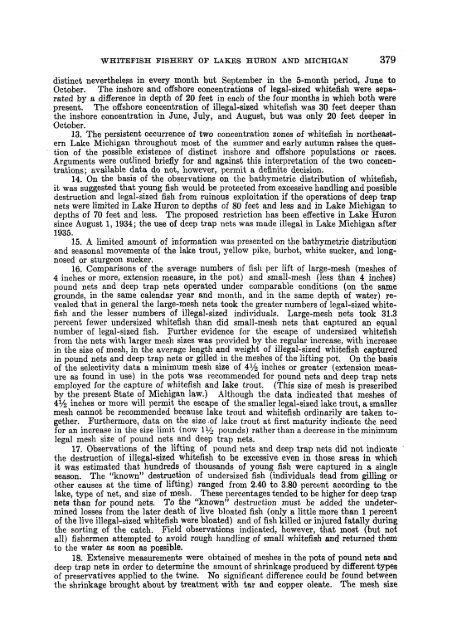Fishery bulletin of the Fish and Wildlife Service - NOAA
Fishery bulletin of the Fish and Wildlife Service - NOAA
Fishery bulletin of the Fish and Wildlife Service - NOAA
Create successful ePaper yourself
Turn your PDF publications into a flip-book with our unique Google optimized e-Paper software.
WHITEFISH FISHERY OF LAKES HURON AND MICHIGAN 379<br />
distinct never<strong>the</strong>less in every month but September in <strong>the</strong> 5-month period, June to<br />
October. The inshore <strong>and</strong> <strong>of</strong>fshore concentrations <strong>of</strong> legal-sized whitefish were separated<br />
by a difference in depth <strong>of</strong> 20 feet in each <strong>of</strong> <strong>the</strong> four months in which both were<br />
present. The <strong>of</strong>fshore concentration <strong>of</strong> illegal-sized whitefish was 30 feet deeper than<br />
<strong>the</strong> inshore concentration in June, July, <strong>and</strong> August, but was only 20 feet deeper in<br />
October.<br />
13. The persistent occurrence <strong>of</strong> two concentration zones <strong>of</strong> whitefish in nor<strong>the</strong>astern<br />
Lake Michigan throughout most <strong>of</strong> <strong>the</strong> summer <strong>and</strong> early autumn raises <strong>the</strong> question<br />
<strong>of</strong> <strong>the</strong> possible existence <strong>of</strong> distinct inshore <strong>and</strong> <strong>of</strong>fshore populations or races.<br />
Arguments were outlined briefly for <strong>and</strong> against this interpretation <strong>of</strong> <strong>the</strong> two concentrations;<br />
available data do not, however, permit a definite decision.<br />
14. On <strong>the</strong> basis <strong>of</strong> <strong>the</strong> observations on <strong>the</strong> bathymétrie distribution <strong>of</strong> whitefish,<br />
it was suggested that young fish would be protected from excessive h<strong>and</strong>ling <strong>and</strong> possible<br />
destruction <strong>and</strong> legal-sized fish from ruinous exploitation if <strong>the</strong> operations <strong>of</strong> deep trap<br />
nets were limited in Lake Huron to depths <strong>of</strong> 80 feet <strong>and</strong> less <strong>and</strong> in Lake Michigan to<br />
depths <strong>of</strong> 70 feet <strong>and</strong> less. The proposed restriction has been effective in Lake Huron<br />
since August 1, 1934; <strong>the</strong> use <strong>of</strong> deep trap nets was made illegal in Lake Michigan after<br />
1935. 15. A limited amount <strong>of</strong> information was presented on <strong>the</strong> bathymétrie distribution<br />
<strong>and</strong> seasonal movements <strong>of</strong> <strong>the</strong> lake trout, yellow pike, burbot, white sucker, <strong>and</strong> longnosed<br />
or sturgeon sucker.<br />
16. Comparisons <strong>of</strong> <strong>the</strong> average numbers <strong>of</strong> fish per lift <strong>of</strong> large-mesh (meshes <strong>of</strong><br />
4 inches or more, extension measure, in <strong>the</strong> pot) <strong>and</strong> small-mesh (less than 4 inches)<br />
pound nets <strong>and</strong> deep trap nets operated under comparable conditions (on <strong>the</strong> same<br />
grounds, in <strong>the</strong> same calendar year <strong>and</strong> month, <strong>and</strong> in <strong>the</strong> same depth <strong>of</strong> water) revealed<br />
that in general <strong>the</strong> large-mesh nets took <strong>the</strong> greater numbers <strong>of</strong> legal-sized whitefish<br />
<strong>and</strong> <strong>the</strong> lesser numbers <strong>of</strong> illegal-sized individuals. Large-mesh nets took 31.3<br />
percent fewer undersized whitefish than did small-mesh nets that captured an equal<br />
number <strong>of</strong> legal-sized fish. Fur<strong>the</strong>r evidence for <strong>the</strong> escape <strong>of</strong> undersized whitefish<br />
from <strong>the</strong> nets with larger mesh sizes was provided by <strong>the</strong> regular increase, with increase<br />
in <strong>the</strong> size <strong>of</strong> mesh, in <strong>the</strong> average length <strong>and</strong> weight <strong>of</strong> illegal-sized whitefish captured<br />
in pound nets <strong>and</strong> deep trap nets or gilled in <strong>the</strong> meshes <strong>of</strong> <strong>the</strong> lifting pot. On <strong>the</strong> basis<br />
<strong>of</strong> <strong>the</strong> selectivity data a minimum mesh size <strong>of</strong> 4V2 inches or greater (extension measure<br />
as found in use) in <strong>the</strong> pots was recommended for pound, nets <strong>and</strong> deep trap nets<br />
employed for <strong>the</strong> capture <strong>of</strong> whitefish <strong>and</strong> lake trout. (This size <strong>of</strong> mesh is prescribed<br />
by <strong>the</strong> present State <strong>of</strong> Michigan law.) Although <strong>the</strong> data indicated that meshes <strong>of</strong><br />
4% inches or more will permit <strong>the</strong> escape <strong>of</strong> <strong>the</strong> smaller legal-sized lake trout, a smaller<br />
mesh cannot be recommended because lake trout <strong>and</strong> whitefish ordinarily are taken toge<strong>the</strong>r.<br />
Fur<strong>the</strong>rmore, data on <strong>the</strong> size .<strong>of</strong> lake trout at first maturity indicate <strong>the</strong> need<br />
for an increase in <strong>the</strong> size limit (now iy2 pounds) ra<strong>the</strong>r than a decrease in <strong>the</strong> minimum<br />
legal mesh size <strong>of</strong> pound nets <strong>and</strong> deep trap nets.<br />
17. Observations <strong>of</strong> <strong>the</strong> lifting <strong>of</strong> pound nets <strong>and</strong> deep trap nets did not indicate<br />
<strong>the</strong> destruction <strong>of</strong> illegal-sized whitefish to be excessive even in those areas in which<br />
it was estimated that hundreds <strong>of</strong> thous<strong>and</strong>s <strong>of</strong> young fish were captured in a single<br />
season. The "known" destruction <strong>of</strong> undersized fish (individuals iead from gilling or<br />
o<strong>the</strong>r causes at <strong>the</strong> time <strong>of</strong> lifting) ranged from 2.40 to 3.80 percent according to <strong>the</strong><br />
lake, type <strong>of</strong> net, <strong>and</strong> size <strong>of</strong> mesh. These percentages tended to be higher for deep trap<br />
nets than for pound nets. To <strong>the</strong> "known" destruction must be added <strong>the</strong> undetermined<br />
losses from <strong>the</strong> later death <strong>of</strong> live bloated fish (only a little more than 1 percent<br />
<strong>of</strong> <strong>the</strong> live illegal-sized whitefish were bloated) <strong>and</strong> <strong>of</strong> fish killed or injured fatally during<br />
<strong>the</strong> sorting <strong>of</strong> <strong>the</strong> catch. Field observations indicated, however, that most (but not<br />
all) fishermen attempted to avoid rough h<strong>and</strong>ling <strong>of</strong> small whitefish <strong>and</strong> returned <strong>the</strong>m<br />
to <strong>the</strong> water as soon as possible.<br />
18. Extensive measurements were obtained <strong>of</strong> meshes in <strong>the</strong> pots <strong>of</strong> pound nets <strong>and</strong><br />
deep trap nets in order to determine <strong>the</strong> amount <strong>of</strong> shrinkage produced by different types<br />
<strong>of</strong> preservatives applied to <strong>the</strong> twine. No significant difference could be found between<br />
<strong>the</strong> shrinkage brought about by treatment with tar <strong>and</strong> copper oleate. The mesh size

















